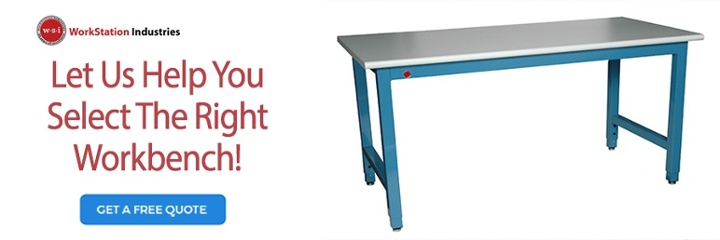A clean lab bench is essential to maintaining production and protecting the integrity of your work. The last thing you want is for leftover dirt or residue to contaminate a future project for your lab.
Because a lab bench is often the most used area of your lab, it’s important to focus on keeping it clean, disinfected and organized.
Here are 8 top tips on how to clean a lab bench and help you maintain a productive and safe space:
-
Follow A Routine Cleaning Schedule
-
Don't Use Harsh Chemicals
-
Use A Gentle Cloth
-
Don't Leave Standing Water On The Bench
-
Consider Exposure To Moisture
-
Don't Leave Stains To Fester
-
Disinfect High Touch Points
-
Don’t Overlook The Benefits Of Storage Solutions
1. Follow A Routine Cleaning Schedule
A common question lab technicians have is: When should the lab bench be cleaned and disinfected?
The answer may depend on your lab’s application, but it’s generally important to follow a routine cleaning and disinfecting schedule that keeps your lab bench in top shape. That may mean cleaning and disinfecting the lab bench after every shift, as well as after any type of spill or contamination. 
If your lab is in the pharmaceutical industry where technicians must preserve the sterility of drugs, technicians may need to clean the workspace more often. For example, chemotherapy drugs are considered hazardous and often contain carcinogens. Therefore, many labs that handle chemo drugs institute routine cleaning schedules that involve disinfecting the lab bench before and after the production of each batch.
2. Don’t Use Harsh Chemicals
While routine cleaning procedures are necessary, harsh chemicals can damage the materials used to create your lab bench. Chemicals like acid drain cleaners, paint remover or strong chlorinated solvents can all damage lab countertops, reversing many of the protections that they provide.
Make sure you check the manufacturer’s recommendations for the particular material your lab bench is constructed with since some surfaces can handle stronger cleaning agents than others. For example, chemical laminate work surfaces can handle the presence of strong chemicals.
However, in general, a mild dish soap and water or an ammonia-based cleaner is safe to use for daily maintenance. (Avoid window cleaners since they can leave waxy build-up on surfaces.) If your lab bench comes in contact with a harsh cleaner, immediately flush the surface with water.
Keep in mind your application as well. If your lab bench is for use in the food industry, you will likely need to choose a commercial-grade, food-safe solution to clean and sanitize it.
It is also generally OK to disinfect your countertops occasionally using a diluted household bleach solution. The Centers for Disease Control and Prevention recommends a 1:100 ratio for disinfection. For every gallon of water, use 5 tablespoons of bleach. Again, check with your countertop’s manufacturer to determine what cleaning agents are safe for your lab bench’s materials.
3. Use A Gentle Cloth
Drop that steel wool pad. While you know it may get the job done and remove whatever stains or substances are on your lab bench, it will likely leave a lot of damage in its wake.
When cleaning your lab bench, never use tools that can damage the surface. These may include cleaning tools like steel wool, wire brushes or scrapers with sharp edges.
Instead, use a gentle fabric on the surface, such as a microfiber cloth or chamois cloth.
4. Don’t Leave Standing Water On Your Bench
It can be tempting to address a spill later after finishing your current task. However, leaving standing water on your bench can damage it, so it’s better to address it immediately.
Some materials used to construct your lab bench are more water and moisture-resistant than others. Epoxy resin surfaces and stainless steel are among those that hold up well to water. That’s why these materials are often used around sinks where high moisture is likely. Other materials like high-pressure laminate and chemical-resistant laminate do not.
In general, it’s better to be safe than sorry and to clean up any spills right away.
5. Consider Exposure To Moisture
While every lab may experience occasional spills, it’s essential to consider just how much moisture is present in your workspace.
Here’s why … if liquids or moisture can penetrate any part of your lab bench, you may find yourself with several problems. Bacteria, fungus, mold and dirt can hide in porous surfaces, impacting the integrity of your lab due to opportunities for cross-contamination. 
That’s why many labs in high moisture environments opt for workstations that have stainless steel cabinets and non-porous work surfaces. Stainless steel is made of low-carbon steel that consists of chromium and nickel, making it resistant to rust and corrosion as well.
6. Don’t Leave Stains To Fester
If you spot a stain, it’s important to take action right away. Stains aren’t aesthetically pleasing, but certain liquids can fester and cause more damage beyond the surface. If left untreated for too long, permanent damage may occur, resulting in the need to replace part of your lab bench.
However, what type of action you take often depends on your lab bench’s materials. Refer to your manufacturer’s instructions for exact directions on dealing with stains since each type of bench may require different cleaning agents or procedures for remedying stains.
For example, steam cleaning epoxy resin countertops can help lift some stains, whereas simply a damp microfiber cloth and standard household cleaner can remove many stains on solid surface countertops.
Hard water stains can be problematic as well in many environments. For solid surface countertops, applying a “Viakal” gel can remove these types of stains. On phenolic resin surfaces, substances like acetone, mineral spirits or isopropyl alcohol are safe to use to clean surfaces.
7. Disinfect High-Touch Points
Many of the tips above assist you with knowing how to clean a lab bench’s surfaces, but what about all of the items that come in contact with a lab bench on a regular basis?
By disinfecting high-touch points regularly, you can create an environment that is resistant to items like germs and dirt. High-touch point areas include:
- Cell phones
- Light switches nearby
- Hand tools and other lab equipment used at the workstation
- Bins and trays
- Drawer handles
- Pens and other writing tools
- Chair backs and armrests
- Keyboards
- Outside of chemical bottles
- Lab doors
If your hands contact these items, you may inadvertently transfer germs, dirt and grime onto your work surface.
Although your lab bench may be your primary workspace, it’s important to keep in mind that tools and other items you use at the lab bench must also be regularly cleaned and disinfected to maintain a clean environment. In highly sterilized environments, it may be wise for lab workers to make a list or take note of equipment they touch during a shift so that each piece is appropriately cleaned or disinfected.
8. Don’t Overlook The Benefits Of Storage Solutions
Finally, one of the keys to a clean workspace is to eliminate clutter. Adding storage to your lab bench can help your workers maintain a clean and organized environment.
Some space-saving solutions you can choose when customizing your lab bench include:
- Utility drawers that come in a variety of sizes and configurations
- Shelving that can be installed below or above the work surface
- Upper storage cabinets
- Articulating monitor arms that can accommodate flat screens and laptops
- Keyboard trays that can be added to any work surface or articulating arm
- CPU holders that can be fixed or adjustable
- Pegboards that can be added between the uprights to attach tools
- Bin rails or panels to store parts and accessories
Our article, How To Customize An Industrial Workbench With Storage, offers additional ideas on how you can maximize your space and promote an efficient work environment.


